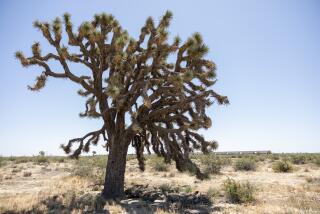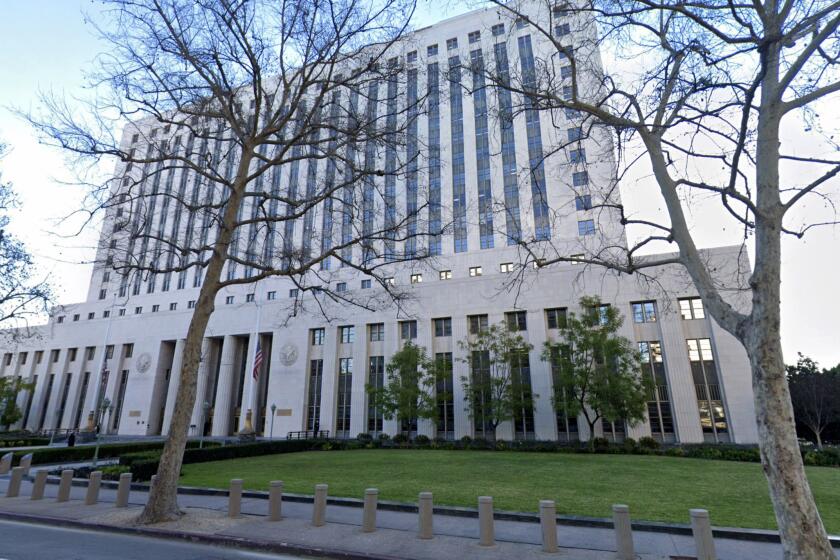Looking for a Way Out of a Forest of Fallen Trees
Got wood?
Probably way too much, if you live in the path of the recent windstorm that toppled hundreds of trees and limbs like some maniacal Paul Bunyan.
As homeowners in the San Gabriel Valley and other hard-hit spots toted up the damage and continued their cleanup efforts Wednesday, they and city officials confronted another knotty problem: What to do with all that timber?
Tree services were swamped with calls from residents and firewood lots had to turn away truckloads of wood. Some stores sold out of chain saws and others reported a run on spare chains as legions of amateur lumberjacks tackled the tangle of downed trees.
“They come in and just want anything that can cut wood--they don’t care what it is,” said Don Mitsuoka, co-owner of a Pasadena store that sold out of chain saws by Tuesday. “We’ve sold more chain than we do all year.”
At least seven communities in the San Gabriel Valley declared local emergencies--a first step toward seeking federal disaster relief.
Monrovia, one of the worst-struck towns, suffered an estimated $1.9 million in damage and lost business because of power outages. La Verne had an estimated $1-million damage and Arcadia tallied about $500,000. Pasadena officials figured it could cost more than $1 million for the cleanup and up to $2 million to repair power lines that belong to the city-run utility.
At least 9,500 homes and businesses remained without electricity, many for the third day, in pockets from the San Fernando Valley to San Bernardino County.
And all over, residents and officials puzzled over how to dispose of thousands of tons of debris.
“We’re struggling to clear the streets. We haven’t made a decision what to do with all the wood yet,” said James Van Winkle, public works director of South Pasadena. “We usually have one of our tree contractors take it, but we have so much wood now we are going to have rethink that.”
Homeowners will be largely on their own to deal with fallen backyard trees, though some cities agreed to collect limited quantities of debris as part of the usual garbage pickup. Several cities set up drop-off bins. Arcadia officials expected to have plenty to offer next time the city holds one of its occasional wood giveaways.
“They’re going to have a field day,” said Arcadia Fire Capt. Don Shawver, in charge of emergency operations.
In Pasadena, many of the 600 felled trees will end up in local fireplaces.
“Trees in the public right-of-way are being cut up on-site and we will leave them there to be taken away as firewood,” said Cynthia Kurtz, Pasadena’s assistant city manager. “I don’t know how people feel about burning their oak trees--it would make me cry--but we will make it available to them.”
While some communities trucked trees to area landfills, La Canada-Flintridge was shipping its wood to the men’s prison in Chino, where it will be processed for use in wood-burning energy plants. San Marino was donating large trunks to the Boy Scouts for firewood and crafts, and La Verne was going to use some to train firefighters in chain-saw technique.
County public works crews picked up debris that residents had piled on the streets of Altadena, but officials promised there would be no more Mr. Nice Guy as the mop-up goes on.
“If we catch them and we know who’s doing it, we ask them to dispose of it on their own,” said Donna Guyovich, spokeswoman for the public works department. “Trees on their property are their responsibility.”
Such self-reliance may not go over so well in ritzy San Marino, where a strict tree law bars homeowners from chopping down even damaged backyard trees unless they are a hazard or “obviously broken off at the trunk,” said John Bingham, assistant city manager. He said the city will send out inspectors to render such life-and-death judgments.
Hassled homeowners elsewhere bombarded tree services and firewood lots with pleas for help, offering free wood if someone would just cut it up.
“Trucks are pulling up right and left trying to drop off firewood, but we don’t have room for it,” said Ken Majors, who tended the office at Holiday Firewood in Pasadena.
Majors said the damage seems to have spawned an overnight wood-cutting industry. “They rent a $19.95 rental truck and buy a $99 chain saw and they’re in business,” he said. “Everybody’s capitalizing on it.”
There was some talk of what effect this windfall will have on the firewood market by the time it is dry enough to burn next year.
“There might be a glut on the market. I had a guy come in yesterday who wanted me to cut up 50 eucalyptus trees,” said Rancho Cucamonga firewood merchant Terry Wolf.
The 80-employee staff at Golden Bear Arborists in Monrovia was going full steam for the third straight day on emergency calls from residents and the cities and public agencies it serves.
Walter Warriner, the firm’s vice president, estimated that his crews had hauled off 500 to 600 tons of branches and fallen trees since Monday. Most of the wood will be ground into chips for roadside landscaping; the rest is cut and sold to firewood dealers or left for the residents, Warriner said.
The downed trees present heartaches as well as headaches.
John Tomlinson, 83, seemed at a loss as workers buzzed to pieces a 50-foot pine tree that he planted next to his Monrovia home 38 years ago. He and his daughter, then 4 years old, planted the sapling; it was his Christmas present to her.
But the stately tree could not withstand Monday’s wind.
“My wife died this year so she didn’t know about the tree falling,” Tomlinson said. “She would have been very sad about it--as I am.”
Correspondent Mayrav Saar contributed to this report.
(BEGIN TEXT OF INFOBOX / INFOGRAPHIC)
Down to the Wire
The hundreds of power crews working around the clock to repair about 6,700 remaining downed power lines face a number of vexing problems.
TANGLES: The wind not only snapped the lines but tangled them in trees. And some non-insulated primary lines atop power poles brushed together and short-circuited.
ACCESS: Because most downed lines are in residential areas, the wires cannot be reconnected by cumbersome booms but must be mended by hand.
LINE REPLACEMENT: When wires suffer minimum damage, they can simply be sleeved together. But this week’s gusts made that a rarity, violently snapping connections and forcing workers to string new lines from pole to pole. Under the best conditions, this operation takes a two-worker crew about an hour.
DOWNED POLES: In some instances, entire poles were toppled. A three-member crew can put up a new pole in about six hours. To do so, the line is de-energized, then the old pole is cut into sections for transport. Only then can the new pole be erected and connected to new circuitry.
Researched by John Gonzales / Los Angeles Times
Source: Southern California Edison
More to Read
Sign up for Essential California
The most important California stories and recommendations in your inbox every morning.
You may occasionally receive promotional content from the Los Angeles Times.







